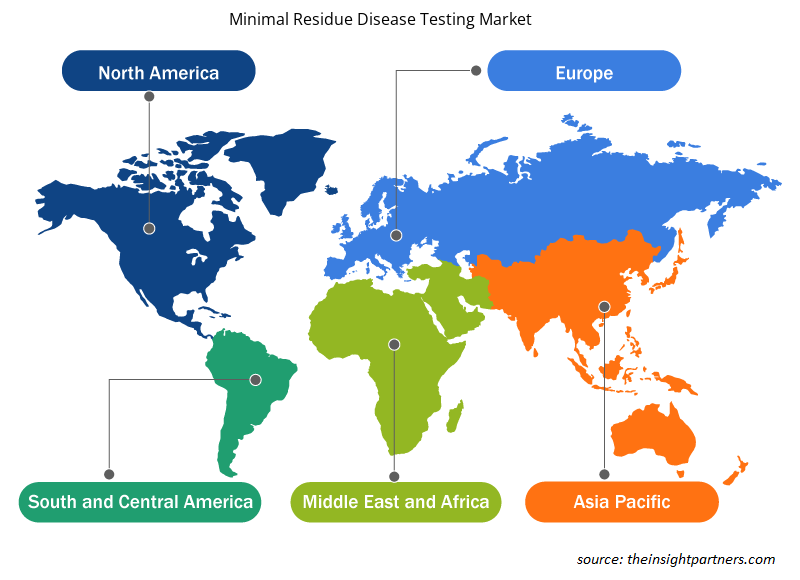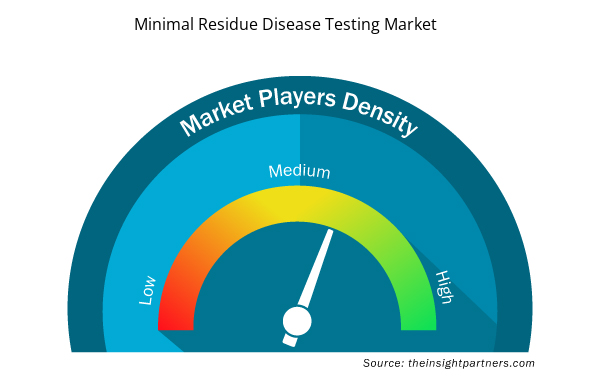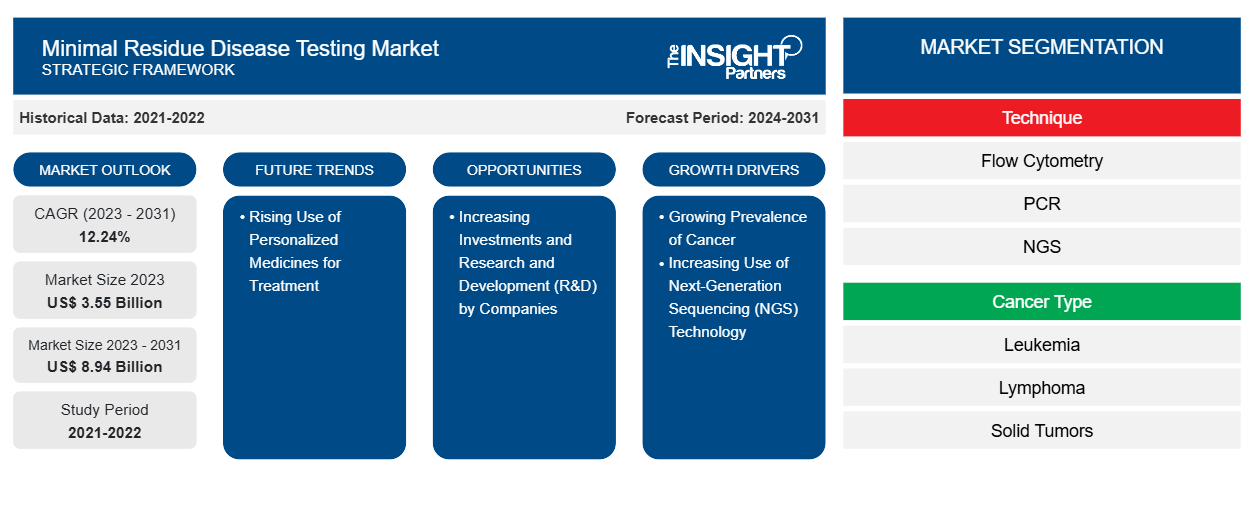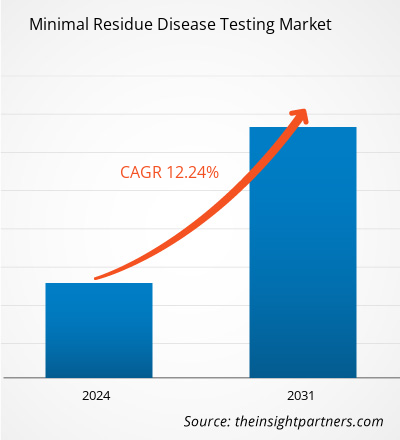微小残留病害检测市场规模预计将从 2023 年的 35.5 亿美元飙升至 2031 年的 89.4 亿美元;预计 2023-2031 年期间的复合年增长率为 12.24%。
分析师观点:
该报告包括由于当前微小残留病检测市场趋势及其在预测期内可预见的影响而产生的增长前景。全球各种癌症(如白血病、淋巴瘤和实体瘤)的患病率不断上升,对微小残留病检测产品和服务的需求也不断增加。医疗保健提供者和研究人员认识到微小残留病评估在监测治疗反应、预测复发和指导治疗干预方面的临床效用。随着微小残留病检测不断发展并成为癌症管理的重要工具,市场参与者专注于创新、标准化和可及性,以利用微小残留病检测市场中的丰厚机会。
市场概况:
将微小残留病检测纳入健康保险计划以及将这种检测方法应用于实体肿瘤诊断是推动微小残留病检测市场发展的因素。随着全球消费者意识的增强,对微小残留病检测的需求也随之增加。医疗保健提供者和研究人员认识到这一趋势,并努力通过将微小残留病检测整合到临床实践中来满足患者的期望。推动微小残留病检测市场增长的其他关键因素包括癌症患病率的上升和下一代测序技术的使用增加。
定制此报告以满足您的需求
您可以免费定制任何报告,包括本报告的部分内容、国家级分析、Excel 数据包,以及为初创企业和大学提供优惠和折扣
- 获取此报告的关键市场趋势。这个免费样品将包括数据分析,从市场趋势到估计和预测。
市场驱动因素:
癌症患病率上升推动市场增长
2020年,癌症病例达到1930万,癌症死亡人数达到996万。根据国际癌症研究机构的数据,预计到2025年癌症病例数将达到2190万,到2030年将达到2460万。根据美国临床肿瘤学会2021年2月的报告,美国约有235,760名成年人(119,100名男性和116,6600名女性)被诊断出患有肺癌。GLOBOCAN 2020的数据显示,印度占全球新发癌症病例总数的18.3%;此外,宫颈癌占所有癌症病例的9.4%。根据美国癌症协会(ACS)的数据,2021年美国发现了近26,560例新的胃癌病例,其中男性16,160例,女性10,400例。美国国家乳腺癌基金会 2021 年 7 月发布的统计数据显示,约 63% 的乳腺癌患者被诊断为局部乳腺癌,27% 被诊断为区域性乳腺癌,6% 被诊断为远处(转移性)疾病。此外,全球血癌患病率的不断上升,也推动了对更好的治疗方案和去除残留癌细胞准确性的需求。根据美国癌症协会发布的统计数据,2022 年 1 月,美国诊断出约 34,920 例多发性骨髓瘤新病例。癌症病例数量的激增可能会迫使政府推出新的癌症预防计划,这有望推动微量残留疾病检测市场的增长。
节段分析:
最小残留疾病检测市场分析已考虑以下几个部分:技术、癌症类型和最终用途。
根据技术,微量残留疾病检测市场细分为流式细胞术、PCR、NGS 等。流式细胞术细分市场在 2023 年占据了最大的市场份额。PCR 细分市场预计在 2023-2031 年期间的复合年增长率最高,为 12.39%。PCR 方法可以根据突变或染色体变化等特征性遗传异常检测癌细胞。该技术必然涉及微小 DNA 或 RNA 片段的扩增,以帮助提高其可检测性和可计数性。即使使用含有少量癌细胞的样本(例如血细胞或骨髓),也可以识别遗传异常。PCR 的高灵敏度使其能够从 100,000 个正常细胞中检测到少至一个癌细胞。获取测试结果可能需要 5-14 天。
根据癌症类型,市场分为白血病、淋巴瘤、实体瘤和多发性骨髓瘤。2023 年,实体瘤细分市场占据了最小残留病检测市场份额的最大值。该细分市场的市场增长归因于正在进行的针对评估实体瘤患者的研究。目前尚无关于使用 MRD 检测检测非血液系统恶性肿瘤的公认建议。将循环肿瘤 DNA (ctDNA) 作为实体瘤治疗后残留分子病诊断的预后生物标志物的方法正在迅速被纳入临床试验设计和转化研究调查中。这种方法适用于标准临床护理。尽管 ctDNA 检测技术发展迅速,但这些检测方法的低灵敏度降低了它们在各种临床应用中检测 MRD 的实用性。
根据最终用户,微量残留病检测市场分为医院、专科诊所、诊断实验室和其他。医院部门在 2022 年占据了微量残留病检测最大的市场份额,预计在 2023-2031 年期间将录得 12.79% 的最高复合年增长率。医院占据了相当大的市场份额,这主要归因于其在急性护理和患者管理中的作用。对于患有严重健康状况的患者来说,住院通常是必要的,因为医院设施可以提高决策能力,让医生和医疗保健专业人员分析患者并为他们提供更好的治疗选择。
区域分析:
微量残留病检测市场报告的范围包括北美、欧洲、亚太地区、中东和非洲以及南美和中美。北美市场在 2023 年的价值为 9.3 亿美元,预计到 2031 年将达到 23.4 亿美元;预计在 2023-2031 年期间的复合年增长率为 12.12%。癌症发病率的显著增加;最新技术的引入;以及已建立的蛋白质组学、基因组学和肿瘤学研究基础设施巩固了北美作为微量残留病检测市场主要贡献者的地位。
亚太地区微量残留病检测市场预计将录得最快的复合年增长率 12.68%。该地区,尤其是印度和中国等国家,拥有庞大的制药业。2021 年 10 月,Genetron Health(中国)和江苏复星(中国)开始在中国商业化 MRD 检测测试。他们过去还在中国专注于血液学的医院和诊所推广过 Seq-MRD。该测试提供准确性、高通量、成本效益、一致性和快速的周转时间。主要市场参与者将研究视为开发新型测试的主要关注领域。除了对研究的日益关注之外,对治疗后癌症患者监测的需求不断增长,继续推动亚太地区微量残留病检测市场的进步。此外,医疗保健基础设施的改善和新兴的制药行业使亚太地区成为市场显着增长和发展的关键枢纽。
关键球员分析:
Adaptive Biotechnologies;Natera;Bio-Rad Laboratories;F-Hoffmann La Roche Ltd;Guardant Health;LabCorp;Sysmex Corporation;ARUP Laboratories;Invivoscribe, Inc.;NeoGenomics Laboratories, Inc.;和 Mission Bio, Inc 是微残留疾病检测市场报告中介绍的关键参与者。
微量残留病害检测市场区域洞察
Insight Partners 的分析师已详细解释了预测期内影响微量残留病害检测市场的区域趋势和因素。本节还讨论了北美、欧洲、亚太地区、中东和非洲以及南美和中美洲的微量残留病害检测市场细分和地理位置。

- 获取微量残留疾病检测市场的区域特定数据
微量残留疾病检测市场报告范围
| 报告属性 | 细节 |
|---|---|
| 2023 年的市场规模 | 35.5亿美元 |
| 2031 年市场规模 | 89.4 亿美元 |
| 全球复合年增长率(2023 - 2031) | 12.24% |
| 史料 | 2021-2022 |
| 预测期 | 2024-2031 |
| 涵盖的领域 | 按技术分类
|
| 覆盖地区和国家 | 北美
|
| 市场领导者和主要公司简介 |
|
最小残留疾病检测市场参与者密度:了解其对业务动态的影响
微量残留病害检测市场正在快速增长,这得益于终端用户需求的不断增长,这些需求源于消费者偏好的不断变化、技术进步以及对产品优势的认识不断提高等因素。随着需求的增加,企业正在扩大其产品范围,进行创新以满足消费者的需求,并利用新兴趋势,从而进一步推动市场增长。
市场参与者密度是指在特定市场或行业内运营的企业或公司的分布情况。它表明在给定市场空间中,相对于其规模或总市场价值,有多少竞争对手(市场参与者)存在。
在微小残留疾病检测市场运营的主要公司有:
- 自适应生物技术,
- 纳特拉,
- Bio-Rad 实验室,
- F-霍夫曼罗氏有限公司,
- Guardant Health,
- LabCorp,
免责声明:上面列出的公司没有按照任何特定顺序排列。

- 了解最小残留疾病检测市场的主要参与者概况
最新动态:
在微量残留病害检测市场运营的公司采用并购作为主要增长战略。根据公司新闻稿,以下列出了一些近期市场发展情况:
- 2023 年 4 月,Quest Diagnostics 收购了 Haystack Oncology,以扩大其肿瘤学产品组合,包括先进的液体活检技术。此次收购使 Quest 能够通过提供具有高灵敏度诊断功能的工具和其他产品来改善个性化癌症治疗。
- 2023 年 4 月,Integrated DNA Technologies 推出了 Archer FUSIONPlex Core Solid Tumor Panel。这一突破性的检测解决方案经过改进和完善,可以覆盖更广泛的单核苷酸变异 (SNV) 和 indel(即插入、缺失或插入和缺失核苷酸)功能或辅助癌症研究。
- 2022 年 12 月,Adaptive Biotechnologies 推出了 clonoSEQ,用于使用循环肿瘤 DNA (ctDNA) 评估弥漫大 B 细胞淋巴瘤 (DLBCL) 患者的微小残留疾病。
- 2022 年 10 月,Adaptive Biotechnologies 与 Epic Systems Corporation 合作,将 clonoSEQ 检测整合到 Epic 的综合电子病历 (EMR) 系统中。clonoSEQ 检测由美国食品药品管理局 (FDA) 监控和批准,用于检测与多发性骨髓瘤 (MM)、慢性淋巴细胞白血病 (CLL) 和 B 细胞急性淋巴细胞白血病 (ALL) 相关的微小残留疾病。
- 2022 年 8 月,罗氏推出了首款数字 LightCycler 系统,旨在准确量化特定 RNA 和 DNA 的微量含量。
- 2022 年 2 月,Personalis 与 Moores Cancer Center 合作,为晚期实体瘤和血液系统恶性肿瘤患者提供临床诊断检测支持。此次合作的重点是使用新推出的液体活检检测方法进行高灵敏度微小残留病和癌症复发检测研究。
- 历史分析(2 年)、基准年、预测(7 年)及复合年增长率
- PEST 和 SWOT 分析
- 市场规模价值/数量 - 全球、区域、国家
- 行业和竞争格局
- Excel 数据集


- Mesotherapy Market
- Asset Integrity Management Market
- Mail Order Pharmacy Market
- Maritime Analytics Market
- Neurovascular Devices Market
- Integrated Platform Management System Market
- Machine Condition Monitoring Market
- Trade Promotion Management Software Market
- Extracellular Matrix Market
- Surgical Gowns Market

Report Coverage
Revenue forecast, Company Analysis, Industry landscape, Growth factors, and Trends

Segment Covered
This text is related
to segments covered.

Regional Scope
North America, Europe, Asia Pacific, Middle East & Africa, South & Central America

Country Scope
This text is related
to country scope.
常见问题
The global minimal residual disease testing market, based on technique is divided into flow cytometry, PCR, NGS, and others. The flow cytometry segment held the largest market share in 2023, and the PCR segment is likely to register the highest CAGR of 12.39% during 2023–2031. Based on cancer type, the market is segmented into leukemia, lymphoma, solid tumors, and multiple myeloma. The solid tumors segment held the largest market share in 2023, and the same segment is estimated to grow at the fastest CAGR during 2023–2031. The lymphoma segment held the second largest market share in 2023. Based on end user, the market is segmented into hospitals, specialty clinics, diagnostic laboratories, and others. The hospitals segment held the largest minimal residue disease testing market share in 2022, and the same is anticipated to register the highest CAGR of 12.79% during 2023–2031.
The minimal residual disease testing market is expected to be valued at US$ 8.94 billion in 2031.
The minimal residual disease testing market was valued at US$ 3.55 billion in 2023.
The minimal residual disease testing market majorly consists of the players such as Adaptive Biotechnologies; Natera; Bio-Rad Laboratories; F-Hoffmann La Roche Ltd; Guardant Health; LabCorp; Sysmex Corporation; ARUP Laboratories; Invivoscribe, Inc.; NeoGenomics Laboratories, Inc.; and Mission Bio, Inc.
The factors driving the growth of the minimal residual disease testing market include the surging prevalence of cancer and the increasing use of next-generation sequencing technology.
Patients achieving complete hematologic remission after blood cancer treatment may foster residual cancer cells in the bone marrow or peripheral blood. These cells can result in relapse, as they persist at levels so low that they cannot be detected by conventional cytomorphology. Similar is the case with several other cancer conditions, including solid tumors and multiple myeloma. Minimal residual disease testing is employed to detect and quantify cancer cells existing in small numbers in a patient's body. This testing is performed by using sensitive technologies such as polymerase chain reaction (PCR), next-generation sequencing (NGS), and flow cytometry to identify measurable residual disease at the molecular level. Minimal residual disease testing is clinically important because it helps monitor response to treatment, predicts risk of relapse, guides personalized therapies, and serves as an endpoint in clinical trials.
Trends and growth analysis reports related to Life Sciences : READ MORE..
The List of Companies - Minimal Residual Disease Testing Market
- Adaptive Biotechnologies
- Natera
- Bio-Rad Laboratories
- F-Hoffmann La Roche Ltd
- Guardant Health
- LabCorp
- Sysmex Corporation
- ARUP Laboratories
- Invivoscribe, Inc.
- NeoGenomics Laboratories, Inc.
- Mission Bio, Inc.
The Insight Partners performs research in 4 major stages: Data Collection & Secondary Research, Primary Research, Data Analysis and Data Triangulation & Final Review.
- Data Collection and Secondary Research:
As a market research and consulting firm operating from a decade, we have published and advised several client across the globe. First step for any study will start with an assessment of currently available data and insights from existing reports. Further, historical and current market information is collected from Investor Presentations, Annual Reports, SEC Filings, etc., and other information related to company’s performance and market positioning are gathered from Paid Databases (Factiva, Hoovers, and Reuters) and various other publications available in public domain.
Several associations trade associates, technical forums, institutes, societies and organization are accessed to gain technical as well as market related insights through their publications such as research papers, blogs and press releases related to the studies are referred to get cues about the market. Further, white papers, journals, magazines, and other news articles published in last 3 years are scrutinized and analyzed to understand the current market trends.
- Primary Research:
The primarily interview analysis comprise of data obtained from industry participants interview and answers to survey questions gathered by in-house primary team.
For primary research, interviews are conducted with industry experts/CEOs/Marketing Managers/VPs/Subject Matter Experts from both demand and supply side to get a 360-degree view of the market. The primary team conducts several interviews based on the complexity of the markets to understand the various market trends and dynamics which makes research more credible and precise.
A typical research interview fulfils the following functions:
- Provides first-hand information on the market size, market trends, growth trends, competitive landscape, and outlook
- Validates and strengthens in-house secondary research findings
- Develops the analysis team’s expertise and market understanding
Primary research involves email interactions and telephone interviews for each market, category, segment, and sub-segment across geographies. The participants who typically take part in such a process include, but are not limited to:
- Industry participants: VPs, business development managers, market intelligence managers and national sales managers
- Outside experts: Valuation experts, research analysts and key opinion leaders specializing in the electronics and semiconductor industry.
Below is the breakup of our primary respondents by company, designation, and region:

Once we receive the confirmation from primary research sources or primary respondents, we finalize the base year market estimation and forecast the data as per the macroeconomic and microeconomic factors assessed during data collection.
- Data Analysis:
Once data is validated through both secondary as well as primary respondents, we finalize the market estimations by hypothesis formulation and factor analysis at regional and country level.
- Macro-Economic Factor Analysis:
We analyse macroeconomic indicators such the gross domestic product (GDP), increase in the demand for goods and services across industries, technological advancement, regional economic growth, governmental policies, the influence of COVID-19, PEST analysis, and other aspects. This analysis aids in setting benchmarks for various nations/regions and approximating market splits. Additionally, the general trend of the aforementioned components aid in determining the market's development possibilities.
- Country Level Data:
Various factors that are especially aligned to the country are taken into account to determine the market size for a certain area and country, including the presence of vendors, such as headquarters and offices, the country's GDP, demand patterns, and industry growth. To comprehend the market dynamics for the nation, a number of growth variables, inhibitors, application areas, and current market trends are researched. The aforementioned elements aid in determining the country's overall market's growth potential.
- Company Profile:
The “Table of Contents” is formulated by listing and analyzing more than 25 - 30 companies operating in the market ecosystem across geographies. However, we profile only 10 companies as a standard practice in our syndicate reports. These 10 companies comprise leading, emerging, and regional players. Nonetheless, our analysis is not restricted to the 10 listed companies, we also analyze other companies present in the market to develop a holistic view and understand the prevailing trends. The “Company Profiles” section in the report covers key facts, business description, products & services, financial information, SWOT analysis, and key developments. The financial information presented is extracted from the annual reports and official documents of the publicly listed companies. Upon collecting the information for the sections of respective companies, we verify them via various primary sources and then compile the data in respective company profiles. The company level information helps us in deriving the base number as well as in forecasting the market size.
- Developing Base Number:
Aggregation of sales statistics (2020-2022) and macro-economic factor, and other secondary and primary research insights are utilized to arrive at base number and related market shares for 2022. The data gaps are identified in this step and relevant market data is analyzed, collected from paid primary interviews or databases. On finalizing the base year market size, forecasts are developed on the basis of macro-economic, industry and market growth factors and company level analysis.
- Data Triangulation and Final Review:
The market findings and base year market size calculations are validated from supply as well as demand side. Demand side validations are based on macro-economic factor analysis and benchmarks for respective regions and countries. In case of supply side validations, revenues of major companies are estimated (in case not available) based on industry benchmark, approximate number of employees, product portfolio, and primary interviews revenues are gathered. Further revenue from target product/service segment is assessed to avoid overshooting of market statistics. In case of heavy deviations between supply and demand side values, all thes steps are repeated to achieve synchronization.
We follow an iterative model, wherein we share our research findings with Subject Matter Experts (SME’s) and Key Opinion Leaders (KOLs) until consensus view of the market is not formulated – this model negates any drastic deviation in the opinions of experts. Only validated and universally acceptable research findings are quoted in our reports.
We have important check points that we use to validate our research findings – which we call – data triangulation, where we validate the information, we generate from secondary sources with primary interviews and then we re-validate with our internal data bases and Subject matter experts. This comprehensive model enables us to deliver high quality, reliable data in shortest possible time.


 获取此报告的免费样本
获取此报告的免费样本